
"I will give an account of the so-called camelopard, because it was then introduced into Rome by Caesar for the first time and exhibited to all. This animal is like a camel in all respects except that its legs are not all of the same length, the hind legs being the shorter. Beginning from the rump it grows gradually higher, which gives it the appearance of mounting some elevation; and towering high aloft, it supports the rest of its body on its front legs and lifts its neck in turn to an unusual height. Its skin is spotted like a leopard, and for this reason it bears the joint name of both animals."
Dio, Roman History (XLIII.23.1-2)
The first giraffe to be seen in the classical world appeared in a grand procession staged by Ptolemy II (Philadelphus) to celebrate the Ptolemaieia, a dynastic festival introduced in 279 BC. The parade included chariots pulled by elephants, gazelles, hartebeests, ostriches, zebras, and wild asses (among other birds and domestic animals) and ended with a display of leopards, panthers, lynxes, a rhinoceros—and a lone giraffe (Athenaeus, Deipnosophistae, V.201C). The giraffe brought from Alexandria by Julius Caesar in 46 BC was the first to be seen in Europe. An extraordinary creature, it appeared to the Romans to be part camel and part leopard, and was named after both: camelopardalis or camelopard (Varro, On the Latin Language, V.100; Pliny, Natural History, VIII.xxvii.69; Diodorus Siculus, Library of History, II.51.1; Strabo, The Geography, XVI.4.16; Pausanias, Description of Greece, IX.21.2, who saw in Rome "Indian camels with the color of leopards"; Oppian, Cynegetica, III.461-481; Heliodorus, Aethiopica, X.27, who remarks on the gait). The scientific name is similar to the ancient: Giraffa camelopardalis.
Aside from its appearance—the long neck and short hind legs, the dappled hide and bright eyes—the ancients remarked on the gentleness of the animal. Pliny calls it an ovis ferae ("wild sheep") and Heliodorus comments that it could be led by a small cord about its neck. Rather uncharitably, Gibbon dismisses the giraffe as "the tallest, the most gentle, and the most useless of the large quadrupeds" (The Decline and Fall of the Roman Empire, I.4).
Caesar's return to Rome (to be followed by Cleopatra, who even may have presented the giraffe as a gift) and the end of civil war was celebrated with five separate triumphs (Suetonius, Life of Caesar, XXXVII.1; Velleius Paterculus, Roman History, II.56.2). As part of these magnificent displays, Caesar exhibited his giraffe "at the games in the Circus" (Pliny, VIII.xxvii.69). To commemorate the dedication of the Temple of Venus Genetrix, putative founder of the Julian clan, and the new Forum of Julius that year (Appian, The Civil Wars, CII), there also were contests in "a kind of hunting-theatre of wood, which was called an amphitheatre from the fact that it had seats all around without any stage. In honour of this and of his daughter [Julia who had died in childbirth almost twenty years before] he exhibited combats of wild beasts and gladiators" (Dio, XLIII.22.3).
Ominously, it is here that Dio injects his description of Caesar's giraffe. One would like to think that a creature so unsuited to the arena did not perish there. And, to be sure, not all venationes involved the hunting and killing of animals, especially if they were being viewed for the first time. Elephants captured in Sicily after the defeat of the Carthaginians, for example, may not have been killed in the triumphal games of 252 BC (VIII.16-17; Pliny cites contradictory sources). And Suetonius remarks of Augustus that "if anything rare and worth seeing was ever brought to the city, it was his habit to make a special exhibit of it in any convenient place on days when no shows were appointed" (XLIII.4). Dio, too, says of Caesar's giraffe that it was "exhibited to all." It does not follow, therefore, that exotic species necessarily were displayed simply to be killed as a public spectacle. But the destruction of the rare or valuable is one demonstration of power and, as Pliny observes about wealth, the proof of it is "to possess something that might be absolutely destroyed in a moment" (XXXIII.ii.5).
Other giraffes continued to be seen (Pliny, VIII.xxvii.69), but the first recorded killing of one does not occur until the late second century AD, when Commodus slaughtered a giraffe and rhinoceroses, as well as five hippopotamuses and two elephants in two days (Dio, LXXIII.10.3, who may have witnessed the event). In AD 248, Philip the Arab celebrated the millennium of Rome's founding with the display in the Circus of ten giraffes, elephants, tigers, lions, leopards, hippopotamuses, and a rhinoceros (Historia Augusta, XXXIII.1). This was the largest number of live giraffes ever brought together, although Aurelian is said to have marked his triumph over Zenobia, queen of Palmyra, in AD 274 with a presentation of giraffes (Historia Augusta, XXXIII.4).
The detail (above) is from a marble sarcophagus in the Walters Art Museum (Baltimore) depicting the triumph of Dionysus, who rides in a chariot pulled by panthers and is accompanied by other exotic animals, including elephants and a giraffe. It dates to about AD 190, toward the end of Commodus' rule, when the emperor was most obsessed with beast fights and gladiatorial combat.
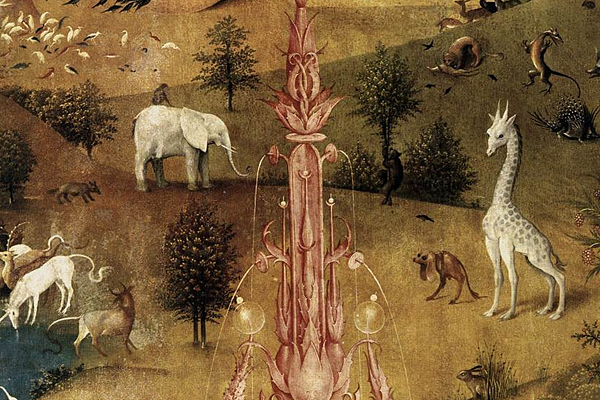
"If Democritus by any means came back from the other world to this, he'd have a good laugh. Whatever the eyes of the crowd were fixed upon—some hybrid monster, perhaps, half camel, half leopard, or an albino elephant—his gaze would be fixed much more attentively upon the crowd itself than on the spectacle. They'd give him more material for laughter."
Horace, Epistle II.1 (194ff)
In the Life of Horace, Suetonius records that Augustus, having read some of the poet's work, was piqued that he wrote to others but had not addressed anything to him. Was he worried, the emperor asked in a letter quoted by Suetonius, that his reputation would suffer if he appeared to be Augustus' friend? Stung by the friendly reproach, in about 12 BC Horace penned To Augustus (Epistle II.1), an epistolary poem on the state of Roman literature, the opening lines of which Suetonius quotes.
In it, Horace confesses that he has no desire to be a playwright, certainly not if, in the middle of the performance, the mob (plebecula, the contemptuous diminutive of plebs) in the back row calls out for boxers or bears. Or if the audience is more attentive to the spectacle on stage, the costumes and sets, than to the words of the author, which cannot be heard over the roar of applause—for the costumes. At least Democritus, were he to return after four hundred years, would find the audience more amusing than whatever was on stage, even if one could not really tell what it was.
Horace is thinking of the giraffe and of Terence, who wrote more than a century and a half earlier. In the prologues to Hecyra ("The Mother-in-Law') Terence, too, had complained about an inattentive and distracted audience. His first production had been disrupted by vitium et calamitas ("disaster and calamity"), in this case the rumor that there would be rope-dancing. One can imagine its appeal. The virtuoso display of the tightrope walker is what Horace himself sought to achieve. "For me the good playwright poet is like a marvelous high-wire acrobat who, walking on air, can scare me to death, and then momentarily calm me down, and then scare me to death all over again" (210ff).
After this mishap, Terence was obliged to stage his play again, with a second prologue. The first time, he complains that "when I began to act this Play, the vauntings of boxers, the expectation of a rope-dancer, added to which, the throng of followers, the noise, the clamor of the women, caused me to retire from your presence before the time." But this performance, too, was a disaster, with people flocking to the theater on the rumor of a gladiatorial show and causing a tumult as they clamored and fought for their places.
Diversum confusa genus panthera camelo: the camelopard may divert the gaze but still be a monstrosity. Horace begins his Ars Poetica with a query. If a painter were to put a man's head on a horse's neck and then add multicolored feathers and various other body parts or combine a beautiful woman with the tail of a fish could there not be anything be laughter at such an unnatural spectacle? Whether a painter or poet, the artist should be consistent and not represent the impossible (creatures such as centaurs or scyllas), compositions that violate the laws of nature just as an ornamental digression (purpureus pannus, "purple patch") disrupts the rules of art. The savage should not be joined with the gentle, snakes paired with birds, lambs with tigers. "In short, let the work be anything you like, but let it at least be one, single thing" (line 23; citing Horace, Quintilian condemns a mixture of styles as well in Institute of Oratory, VIII.3.60). It is this appearance of not being one thing that rendered the incongruity of giraffe so offensive to the aesthetic of Horace.
In the left-hand panel of The Garden of Earthly Delights (1505-1510), on either side of the Fountain of Life (above), Hieronymus Bosch portrays the two animals that so entranced the fickle Romans: a white elephant and a camelopard. Bosch may have copied his giraffe from a drawing by Cyriacus of Ancona (who enjoyed the patronage of Cosimo de' Medici) made about 1435. If Bosch visited Florence sometime between 1487 and 1489, he may have seen a giraffe for himself.
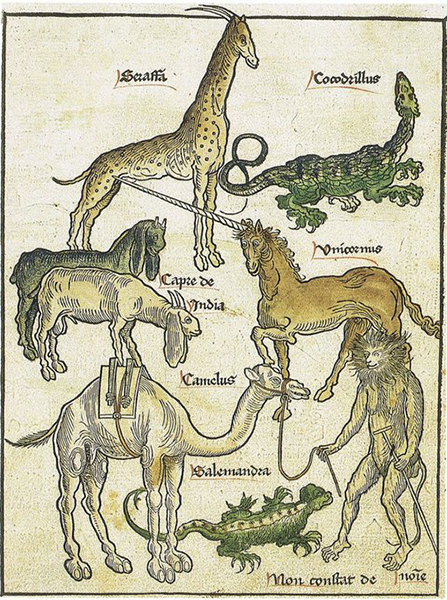
Although there are earlier painted images of a giraffe, the first depiction to appear in print is a woodblock by Erhard Reuwich. Published in 1486, it illustrates an account of a pilgrimage to the Holy Land for which he provided the illustrations, the animals said to have been truly depicted as he saw them. But the claim is suspect, given that the long horns of the giraffe make it look more like an antelope—and the inclusion of a unicorn and a man with a tail and prehensile feet.
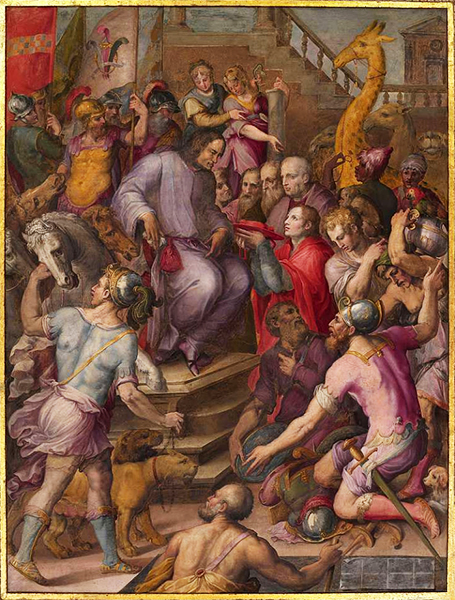
"Therefore it is unnecessary for a prince to have all the good qualities I have enumerated, but it is very necessary to appear to have them. And I shall dare to say this also, that to have them and always to observe them is injurious, and that to appear to have them is useful."
Niccolò Machiavelli, The Prince (XVIII)
Late in 1487, in an attempt to establish better diplomatic relations with Florence against the Ottoman Turks, the sultan of Egypt presented a gift to Lorenzo de' Medici (the Magnificent)—a female giraffe, the first to be seen in Italy in more than 1,500 years. Allowed to wander the streets, eating from the hands of children and raising its head to take apples and other fruit offered from second-story windows by the noblewomen of Florence, the animal was a sensation, invariably evoking astonishment and delight (as it had for Heliodorus in the third century AD). As one diarist recorded at the time, the giraffe was molto grande e molto bella e piacvola, "very tall, very beautiful, and pleasing." (Indeed, the word "giraffe" derives from the Arabic zarāfa, "lovely one.")
Lorenzo was a tyrant accused of subverting republican principles and becoming increasingly despotic, and he no doubt saw a parallel between himself and Caesar. Certainly, the giraffe would have enhanced the prestige of a prince powerful enough to have acquired such a marvelous creature—just as Caesar's giraffe had done.
In a ceiling fresco in the Palazzo Vecchio (Florence) commissioned by Cosimo I de' Medici, Lorenzo is seated before his ambassadors, his thirteen-year-old son before him in the crimson robe of a cardinal, and towering over all—the Medici giraffe. It died less than two years later of a broken neck when the animal apparently tried to extricate itself after being caught in the rafters of its stall. By 1492, Lorenzo himself was dead.
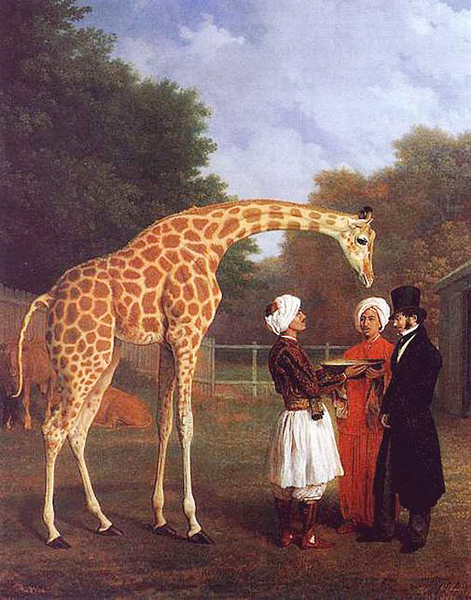
In 1826 Muhammad Ali, the Ottoman viceroy in Egypt, presented a giraffe to both Charles X of France and George IV of England and, two years later, to the Hapsburg emperor Franz II of Austria, the first to be seen in those countries. Indeed, it had been 340 years since Anne de France had written to Lorenzo de' Medici, beseeching him to keep a promise to send his own giraffe to her, "for this is the beast of the world that I have the greatest desire to see." They were diplomatic gifts intended to mollify public sentiment at the treatment of the Greeks during their war of independence, and caused a sensation in art and fashion in la mode à la Girafe. But they did not prevent a combined British, French, and Russian naval force from decisively defeating the Ottoman Turks a few months later at the Battle of Navarino, in what was to be the last engagement fought with sailing ships.
Lots apparently having been drawn by the consuls of each country, the smaller of the two young giraffes was awarded to George IV. But, lashed to the back of a camel when it no longer could walk, it had been injured during its journey and the legs crippled. The animal arrived in England in 1827 and was tended in a building on the grounds of Windsor Castle out of public view. Requiring the aid of a special harness to stand, within two years the wretched creature weakened and died.
The Nubian Giraffe of George IV (above) was painted in about 1827 by Jacques-Laurent Agasse, who tactfully has omitted the pulley and harness. In the background are the cows used to supply milk to the animal which, not having been weaned, is drinking from a bowl offered by one of the two Arab attendants who had accompanied her from Egypt.
The giraffe presented to Charles X was more fortunate. After debarkation (a hole having been cut in the upper deck to allow her head to poke through), it walked in royal livery to the boisterous acclaim of crowds the 550 miles from Marseille to Paris, where she was presented to the king and ate rose petals from his hand. There, much to the chagrin of the English, the animal lived quietly for the next eighteen years, although its influence on fashion and the interest of the public long had waned. Indeed, such was the national disgrace at the loss of its own giraffe that William IV commissioned a search for a new one. In 1836 three male and one female calf survived the journey to the Zoological Gardens in London, where the first birth in captivity occurred three years later. (The giraffe in Vienna also had suffered during its transport by camel, an injury no doubt aggravated by walking from Trieste to Vienna, where it succumbed to disease within ten months.)
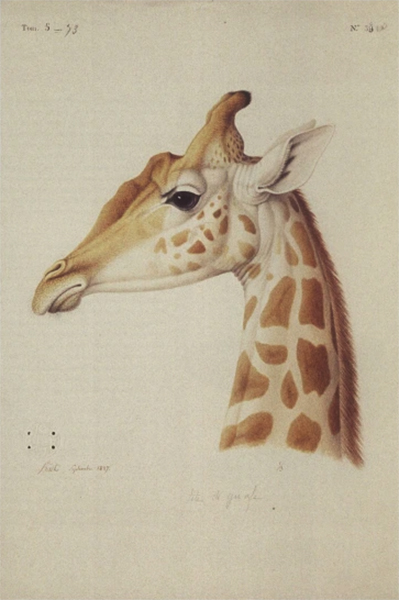
Tête de girafe by Nicolas Huet the Younger is in
the library of the
Muséum
National d'Histoire Naturelle (Paris) which itself is on the grounds of the
Jardin des Plantes, where the giraffe was kept in one of the hexagonal
wings of the Rotonde de la Menagerie, the world's first civil zoo. As Étienne
Geoffroy Saint-Hilaire, who had accompanied the giraffe from Marseille to
Paris and was the first director of the menagerie, so charmingly wrote, her
new home, with its parquet flooring and straw matting on the walls, was
"truly the boudoir of a little lady."
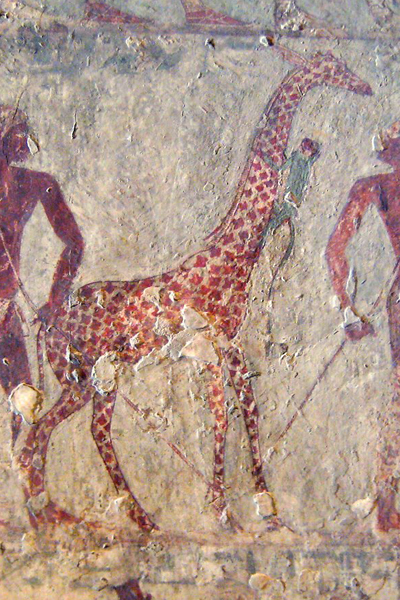
In the pictorial characters of hieroglyphs, a "determinative" is a pictogram placed after the root word (a consonant sound sign) that provides additional semantic information about the word. As well as determining the meaning, it also serves to mark the end of the word. Goldwasser calls these determinatives "classifiers" because they classify the word by specifying its relationship within a systematic categorization, words modified by a particular classifier comprising the same conceptual category.
Metaphorical classifiers, although not often used, are one feature of this system of categories, of which animalistic metaphors are particularly intriguing. For example, the verb sr means "to foresee or foretell, to prophesy or announce events" but, when followed by the pictogram of the giraffe, the sense of both words is changed. As a classifier, the hieroglyph of the giraffe loses its own iconic meaning (that of the animal itself) and creates instead an implicit simile. The verb, too, is modified, moving from its usual domain, prophesy as an action of the senses and emotions, to another, those who see and know before all others, a prescience "like a giraffe."
So iconic is the giraffe to this new category that it shares the same sr consonants (the giraffe also was identified as mmy), signifying both its name and its most important characteristic: the animal that, being so tall, sees before all other creatures. To foresee or foretell, in other words, is to see as a giraffe does. It is the animal's acute eyesight, in fact, that allows the giraffe to communicate visually from a distance greater than permitted by sound or scent (and indeed greater than any other mammal) and gives the giraffe its lofty dignity.
This young giraffe, with a green monkey clinging to its neck, is from the tomb of Rekhmire, vizier during the reigns of Tuthmosis III and Amenhotep II (1490-1410 BC). Located in the Valley of the Nobles at Thebes, the tomb depicts Rekhmire receiving tribute from Nubia on behalf of the pharaoh.
The ostrich confounded the Romans as well. Like the giraffe, it was thought to resemble the camel and so was called struthio camelus, "camel bird" (Pliny, X.i.1) from the Greek struthós, "sparrow." Curiously, just as the same word denotes both the sparrow and the ostrich in Greek, so does passer in Latin. To distinguish between them, a descriptive adjective was added, as when Plautus calls an ostrich running in the Circus passer marinus (Persians, Act I, Scene ii, line 199) because it is brought over the sea.
One of the best representations of the giraffe from the ancient world is the recently discovered mosaic from Lod, Israel.
References: "To Augustus (Epistle 2.1)" (2000) by Horace and David Ferry, Arion, 8(2), 63-73; Suetonius: On Poets (1914) translated by J. C. Rolfe (Loeb Classical Library); Horace: Epistles Book II and Epistle to the Pisones (Ars Poetica) (1989) edited by Niall Rudd; Horace for Students of Literature: The "Ars Poetica" and Its Tradition (1995) by O. B. Hardison, Jr. and Leon Golden; "Lorenzo the Magnificent and the Giraffe as a Symbol of Power" (1987) by Christiane L. Joost-Gaugier, Artibus et Historiae, 8(16), 91-99; "Audience for a Giraffe: European Expansionism and the Quest for the Exotic" (2006) by Erik Ringmar, Journal of World History, 17(4), 375-397; The Story of the Roman Amphitheatre (2000) by D. L. Bomgardner; "Exotics in Post-Medieval European Art: Giraffes and Centaurs" (1991) by Charles D. Cuttler, Artibus et Historiae, 12(23), 161-179; The Giraffe in History and Art (1928) by Berthold Laufer (Field Museum of Natural History, Leaflet 27); The Book of the Giraffe (1968) by C. A. Spinage; Machiavelli: The Prince (1532/1908) translated by W. K. Marriott; "Geoffroy's Giraffe: The Hagiography of a Charismatic Mammal" (2003) by Olivier Lagueux, Journal of the History of Biology, 36(2), 225-247; The Medici Giraffe and Other Tales of Exotic Animals and Power (2006) by Marina Belozerskaya; Zarafa: A Giraffe's True Story, from Deep in Africa to the Heart of Paris (1998) by Michael Allin; Home by a Neck: A Giraffe's Epic Journey from Cairo to Paris (March 1986) by Georges Poisson, The Unesco Courier, 7-9; "La Mode à la girafe: Fashion, Culture, and Politics in Bourbon Restoration France (2009-2010) by Michele Majer, Studies in the Decorative Arts, 17(1), 123-161; Prophets, Lovers, and Giraffes: Wor(l)d Classification in Ancient Egypt (2002) by Orly Goldwasser; "A Comparison between Classifier Languages and Classifier Script: The Case of Ancient Egyptian" by Orly Goldwasser, Egyptian, Semitic, and General Grammar (2009), edited by Gideon Goldenberg and Ariel Shisha-Halevy; Giraffe: Biology, Behaviour and Conservation (2014) by Anne Innis Dagg.